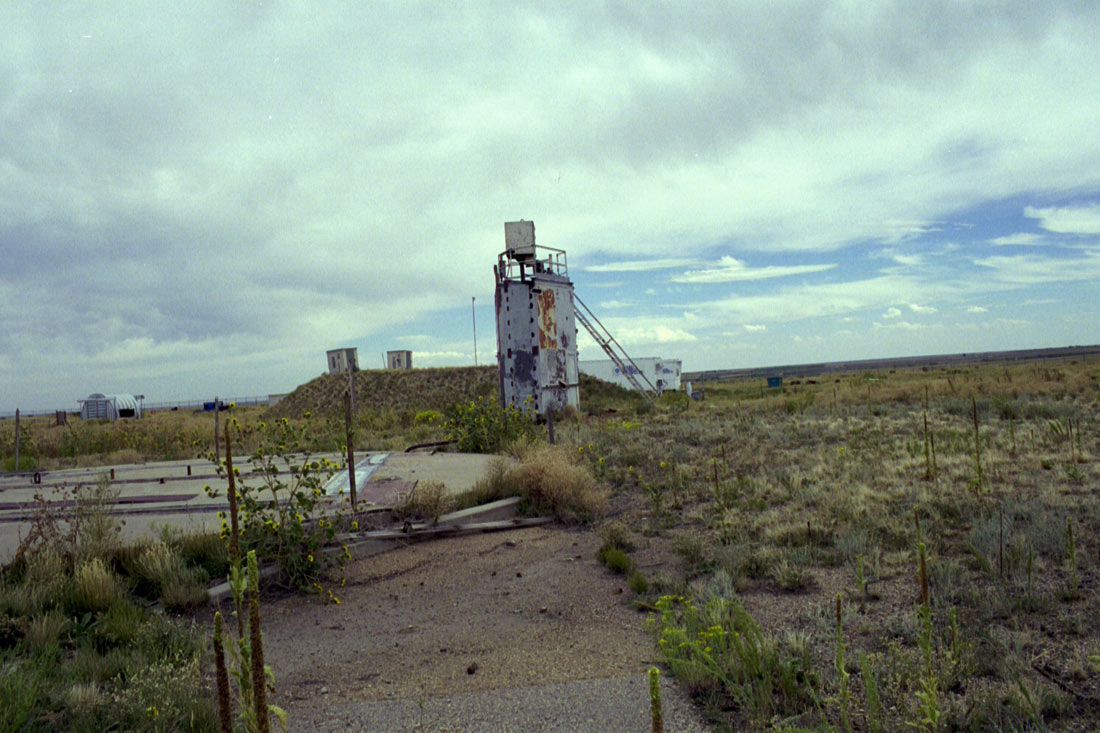To
properly introduce the entry portal, I have to begin at the
surface. You can't naturally get to the subterranean tunnels,
domes and silos without first arriving at this area and so I shall
begin, quite logically, at the beginning.
The
surface, once every bit a military installation and easily identifiable
as such, has been transformed by time. The concrete and asphalt at
Lowry 724-C are cracked, eroding, or just being steadily hidden beneath plant
life. Signs are faded or taken by the wind, and rust attacks every
speck of steel where paint has long peeled away. Concrete spalls
and cracks from the Winter cold and freezing, and all around evidence of
decay and reclamation by natural forces are rampant.
|
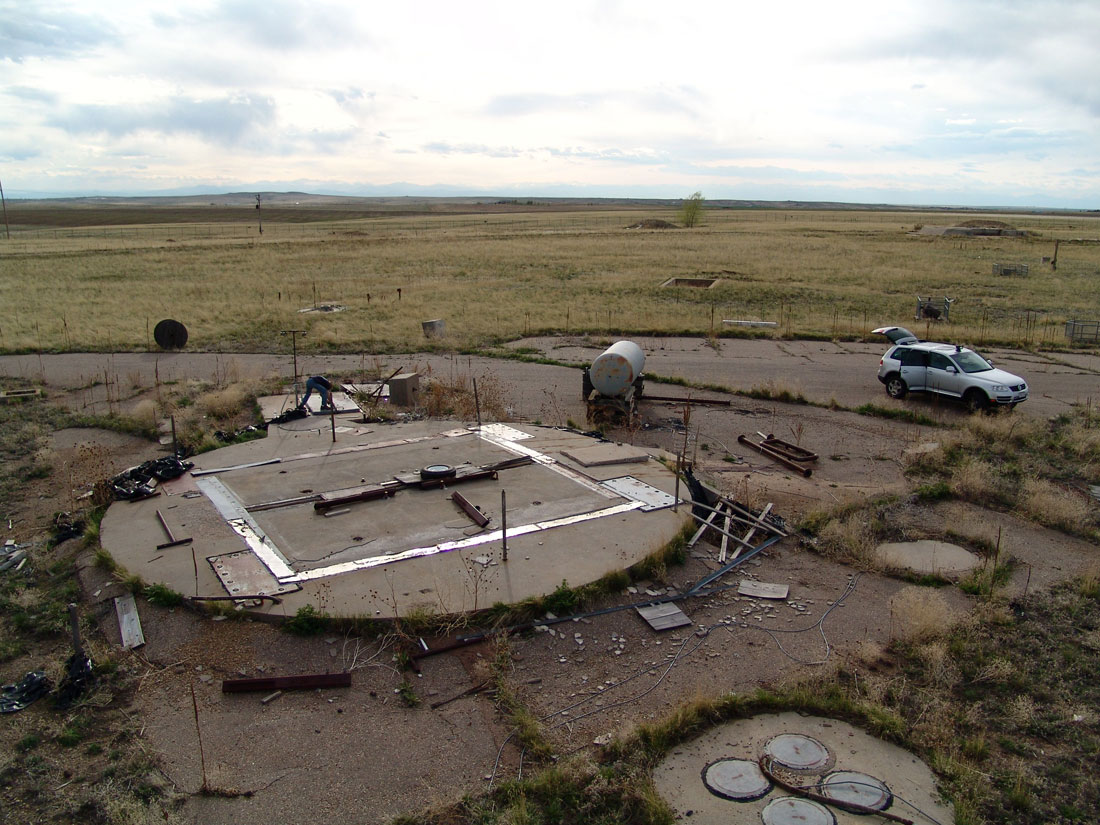
Lowry
724-C, circa 2002: The entry portal viewed from a nearby tower about 15
feet tall. The silo and its door are obvious in this westerly
view. At the right center, the concrete circle is the television
camera tube and at the lower right you can see the four circles of the
instrument assembly tubes which measured wind speed, radiation,
temperature and other important surface conditions.
The
personnel entrance is on the far side of the silo where, if you squint
really hard and use your super keen super vision, you can see me there
mooning the camera.
I
don't know where the tank came from, but it seems to be fairly recent
and not from inside the site. I think it had a date on it saying
it was manufactured in the 1990's.
Photo
courtesy of Sean Malloy
|
|
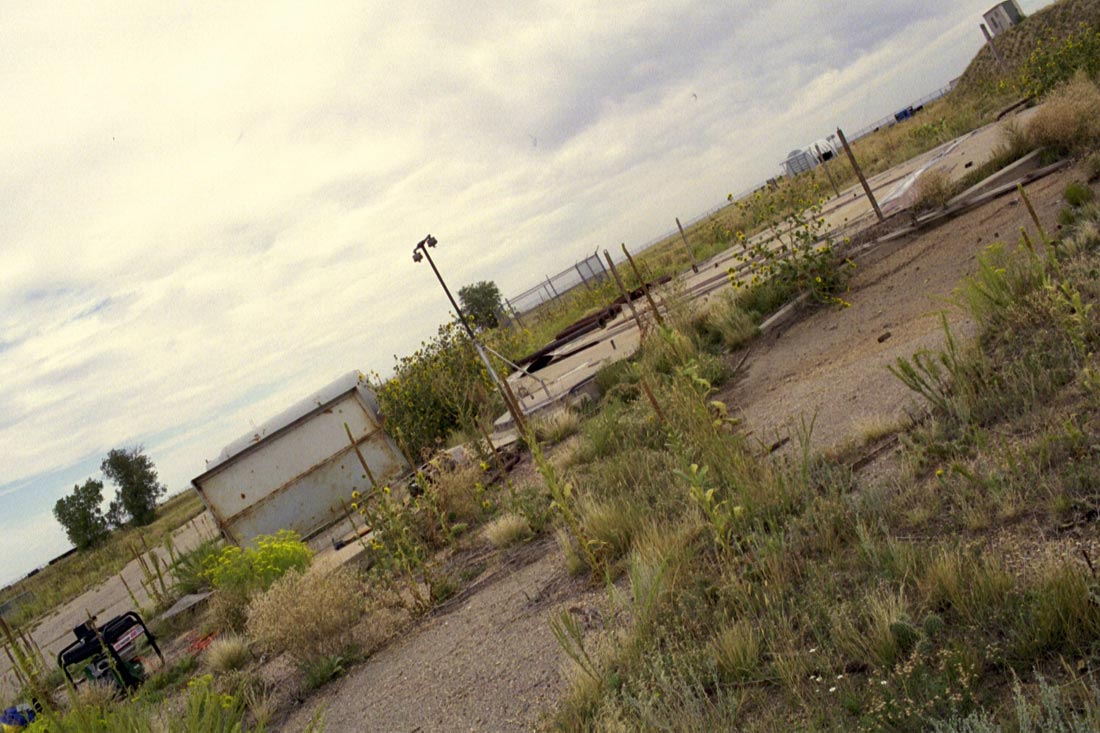
Lowry
724-C, 1999: A shot of the entry portal taken by a man with one leg a
foot shorter than the other.
This used to be all pavement here,
but as you can see, it has become seriously overgrown with scrubby
Colorado plant life.
|
|
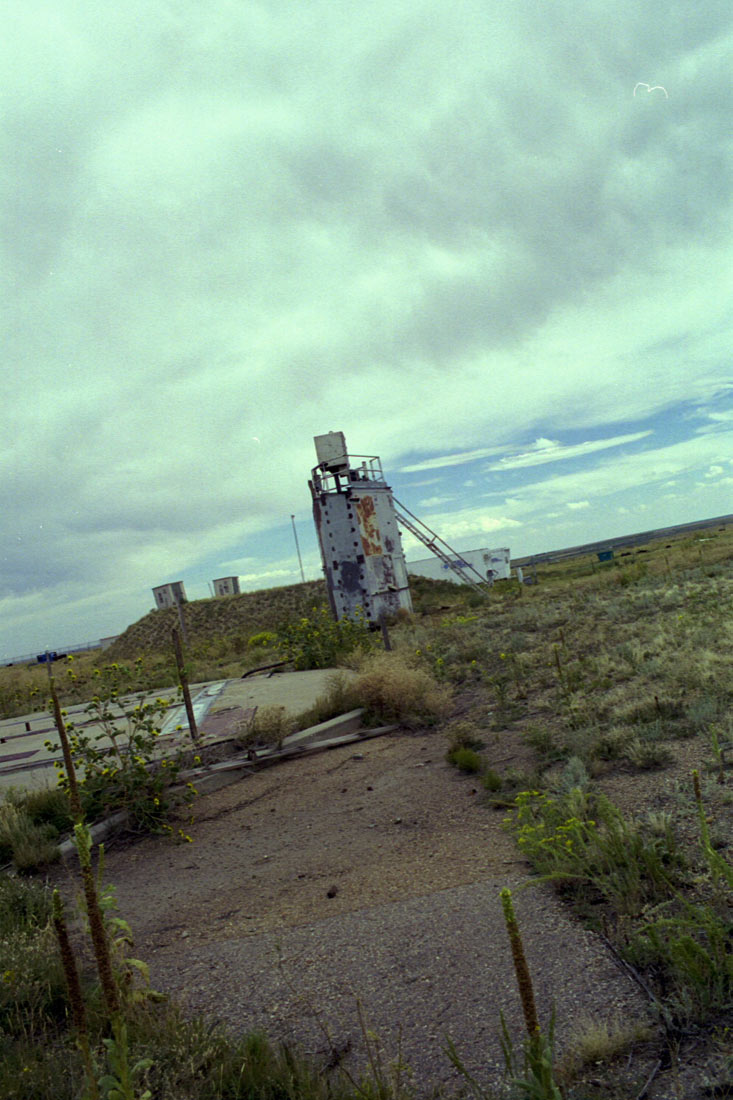
Lowry
724-C, 1999: Portal and tower. The tower is actually constructed
from parts taken from the launcher silos. The bulk of this
structure is made up of the flame deflectors that were designed to
re-direct the exhaust from the missile to protect the missile platform
and silo during launch.
|
|
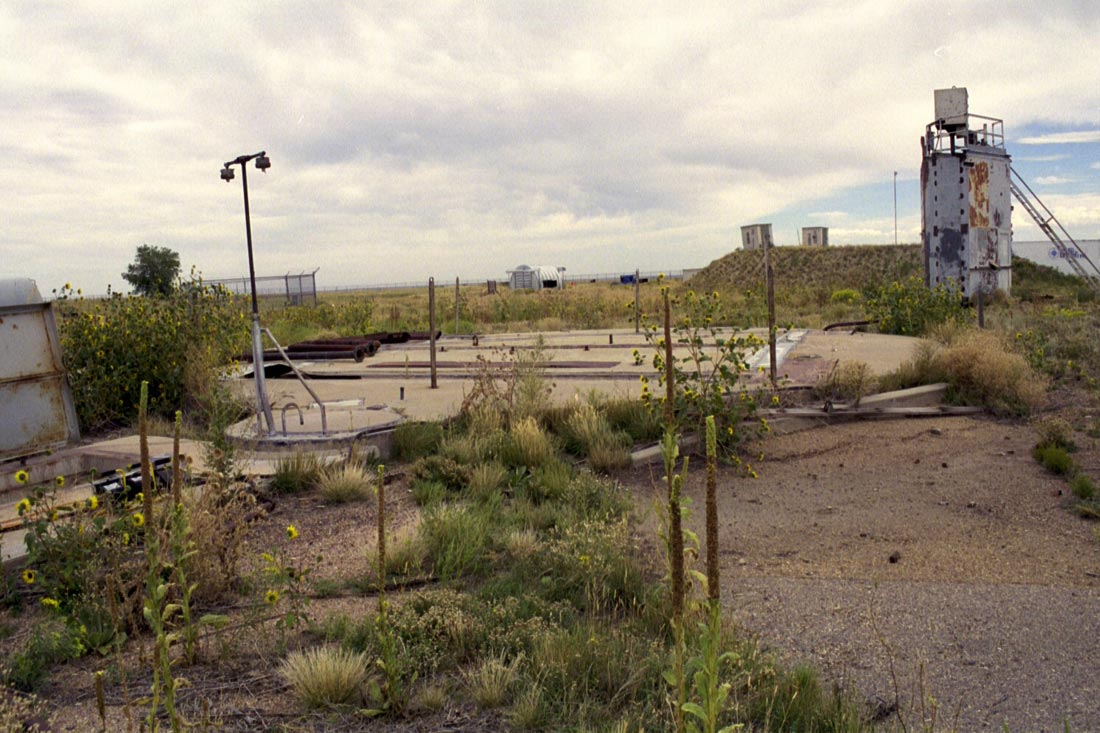
Lowry
724-C, 1999: Entry portal showing the silo doors, old and new personnel
entrances and the tower. Actually there are 2 such towers at 1-C;
the other is located near launcher #2. These towers appear to have
been used to photograph testing done on the surface by contractors after
the site's closure. The testing conducted was unrelated to missile
defense.
|
My
experience of first arriving at 724-C in the Fall of 1999 was one of
delight. Yeah, I find this stuff endlessly fascinating to the
extreme. The most minute of details which most people would never
care to know, I would likely find very interesting. So when I
arrived at the vast complex I was surrounded by mysteries, strange
structures and forms-- some completely obvious, and others completely
enigmatic.
I
spent several hours looking at everything I saw with the sort of
curiosity you'd expect from an alien who'd just landed on the site as
part of an anthropological study.
|

Lowry
724-C, 1999: A better view of the current entrance. This is a
somewhat northeasterly view.
|
|
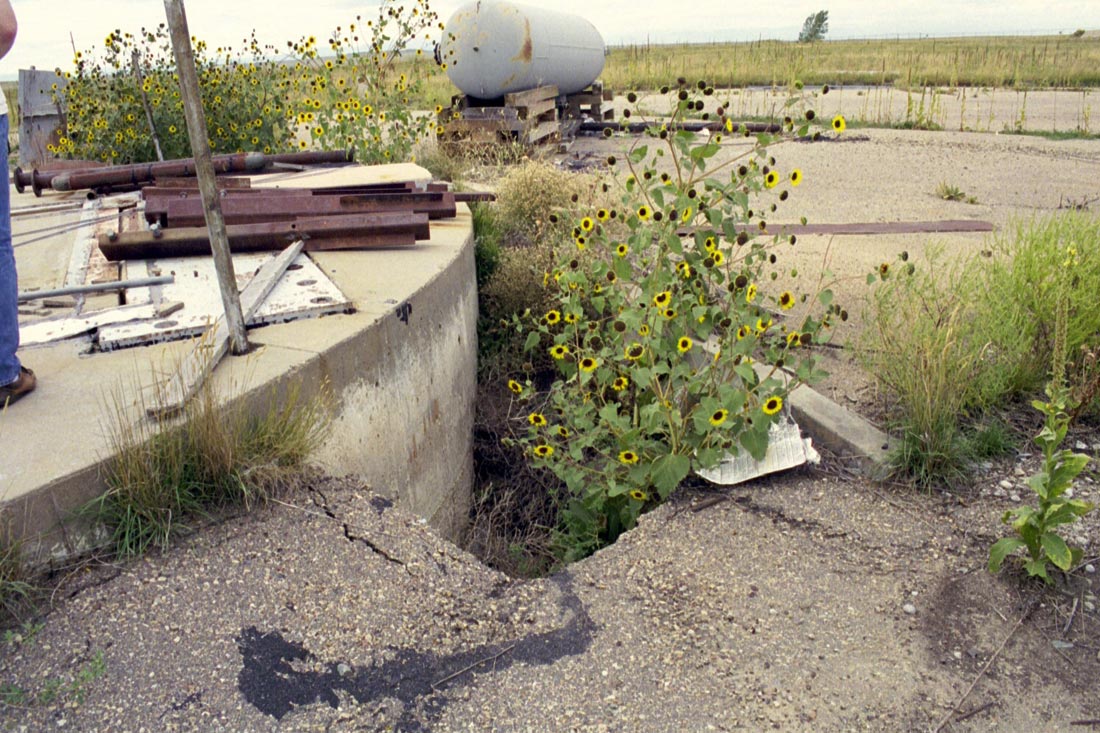
Lowry
724-C, 1999: Settling and erosion around the portal silo.
|
Even
as the underground beckoned me with its fantastic sights, I found it
hard to tear myself away from the silo doors, the unexplained shafts
leading into the darkness and lined with reflecting pools of water, and
the myriad other things I saw. Of course, when the site was opened
up and everyone was ready to go, all distractions on the surface were
forgotten.
|
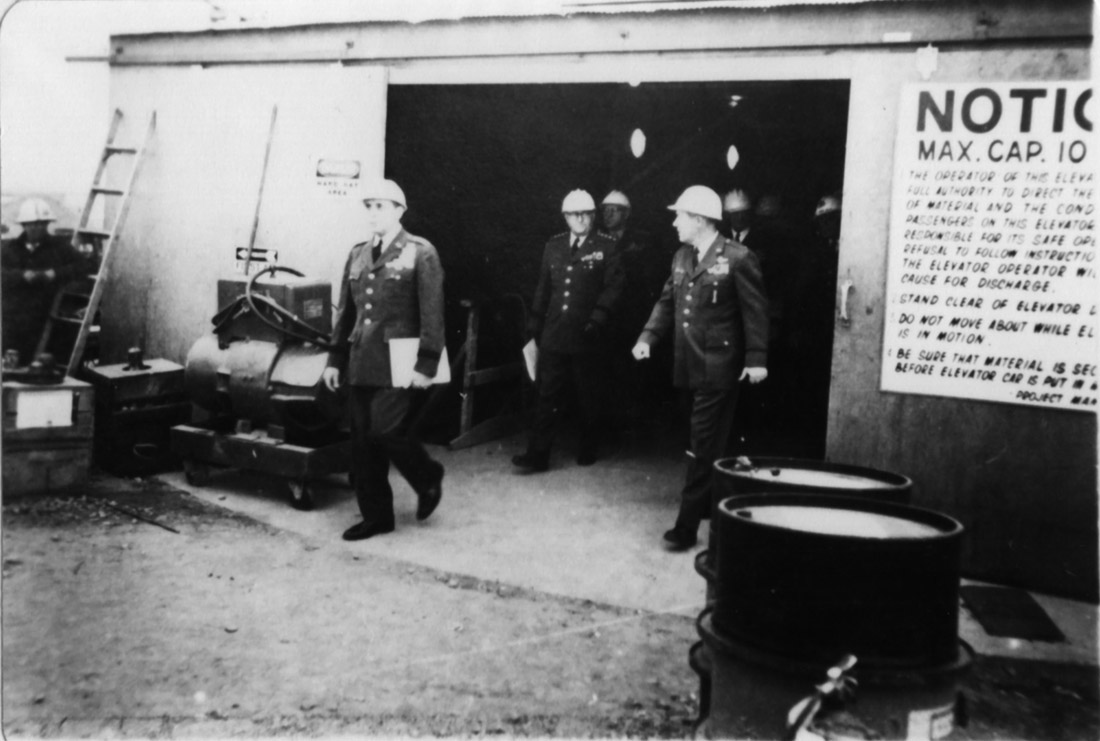
Lowry
724-A: Construction-era photo showing General Lymen Lemnitzer, Joint Chiefs
of Staff chairman (first on the left) and a contingent of high-ranking AF personnel exiting the entry portal.
(In spite of it's dual usage, "Entry/Exit Portal" was
undoubtedly discarded as too unwieldy a title.)
Behind
Gen. Lemnitzer in the glasses is Army Chief of Staff Gen. Decker and
Gen. White. Looking over toward Gen. Decker is Colonel Proctor who
is followed by Chief Naval Officer Admiral Arleigh Burk, making this
quite the group of heavy hitters in US military figures.
A temporary
surface building has been constructed over the portal silo during
construction. Looking more closely, two of the lights in the
elevator car can be seen through the doorway just above the officers'
heads near the top center of the photo.
When
I was at 724-C, I found the very same hand-painted sign as the one shown
at right in this photo lying in the grass near the antenna silos; faded,
peeling and riddled with bullet holes of course.
Photo
courtesy of Fred Epler
|
|

Mountain
Home, 1989: The entry portal silo doors standing open. You can see
here the sheer enormity of the doors' construction when viewed from the
side. Sections of the perimeter fencing appear to have been
scavenged for makeshift safety barriers for the open sides of the silo.
Photo
courtesy of Fred Epler
|
My
very first look at a Titan 1 complex was quite different from what I
would see at 724-C . Years before I arrived at 724-C I was lucky
enough to get a look at 725-A, both inside and out. 725-A looked
quite different, and standing at the entry portal it looked positively
barren. Most of the landmarks of a Titan 1 site (unbeknownst
to me) seemed to be hidden, though at the time I would not have known
where to look for them.
|
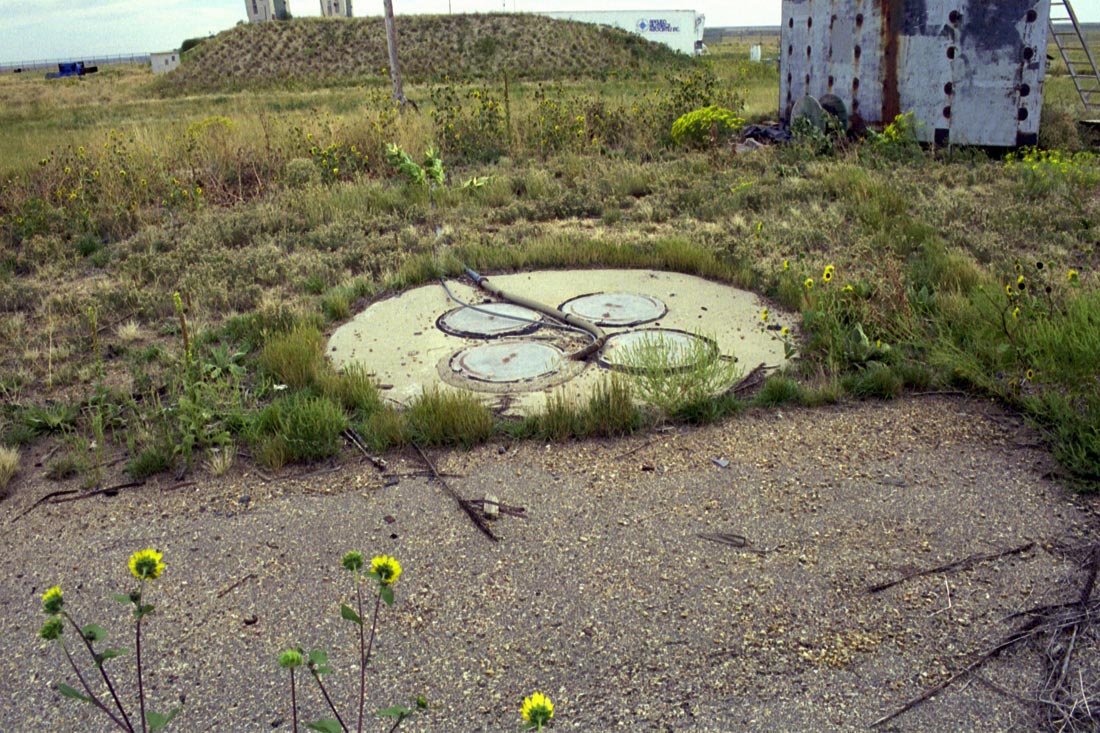
Lowry
724-C, 1999: The instrument tube array, flush in the closed position.
|
|

A
closer view of the instrument tube array at 724-C: You can see some
power lines were routed into the facility by the contractors at the
site. After 724-C closed, a company occupied the site and
conducted testing both on the surface and in the underground
complex. At some point, they used the instrument tube to run
commercial power into the complex-- something which was not available
inside the site after salvage operations.
|
|
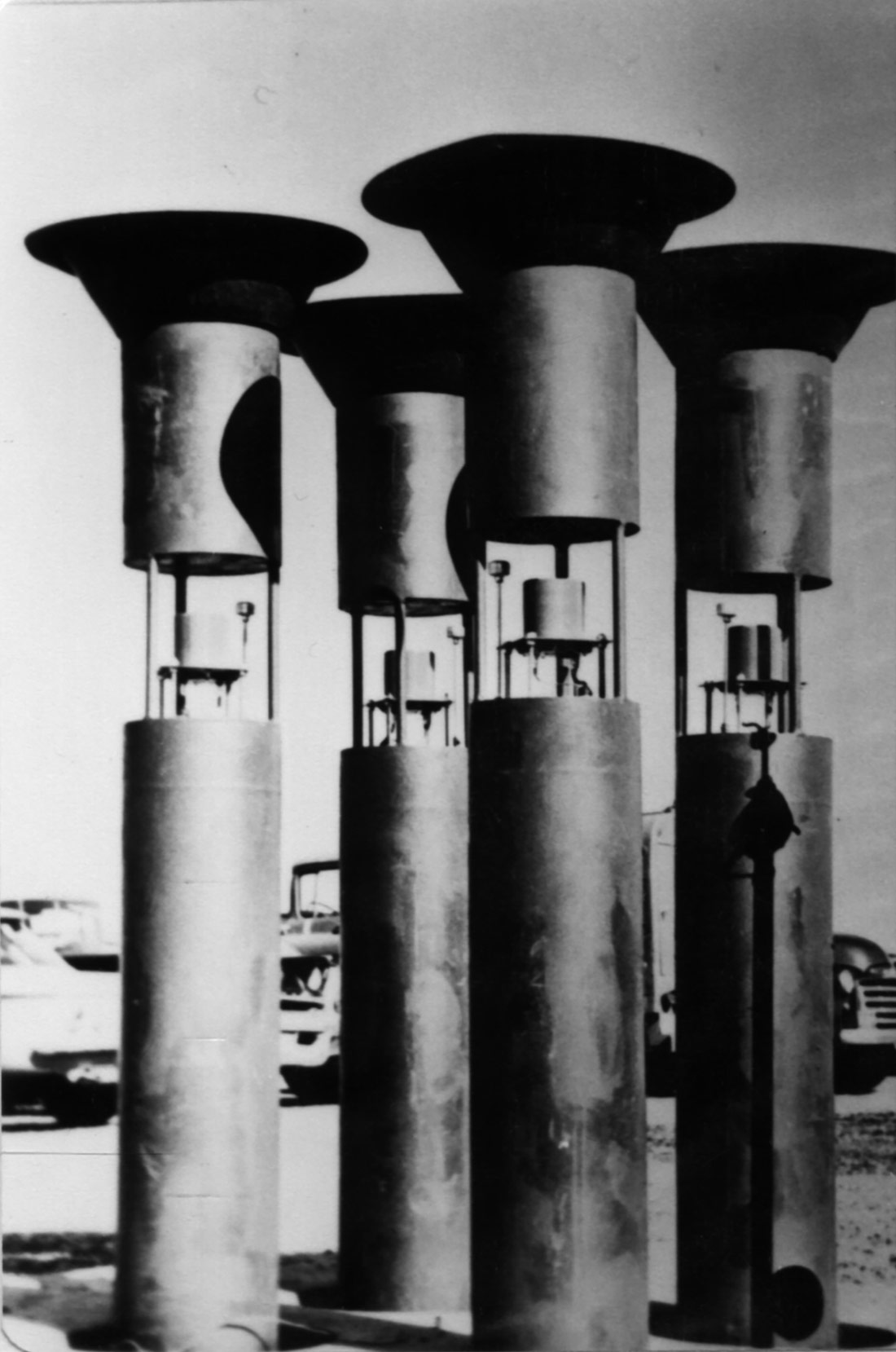
The
instrument array tubes fully deployed.
Photo
courtesy of Fred Epler
|
|
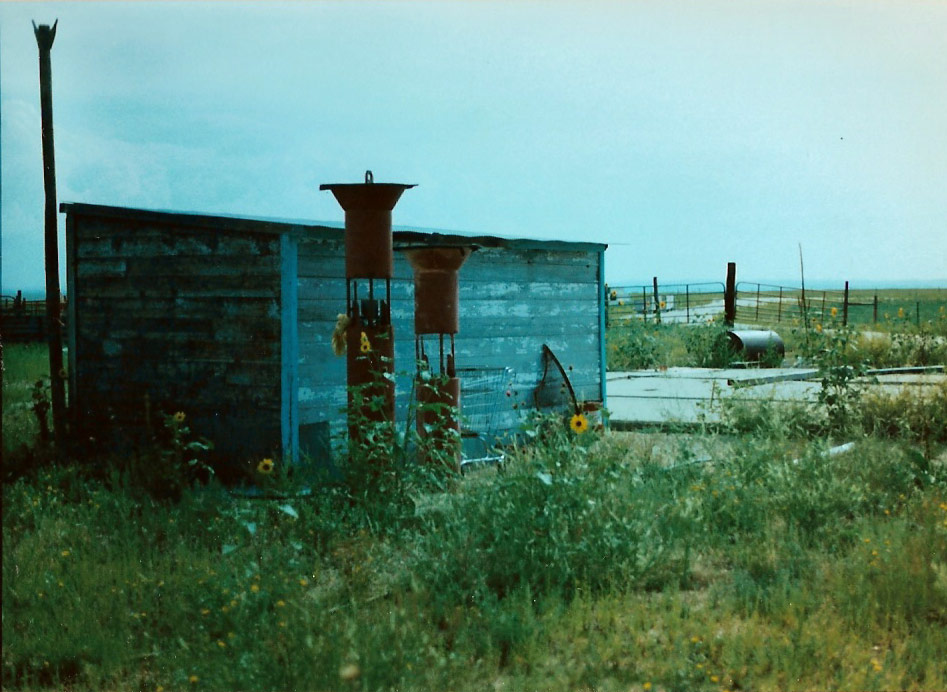
Lowry
724-B: Partially deployed instrument array tubes.
Photo
courtesy of Fred Epler
|
|
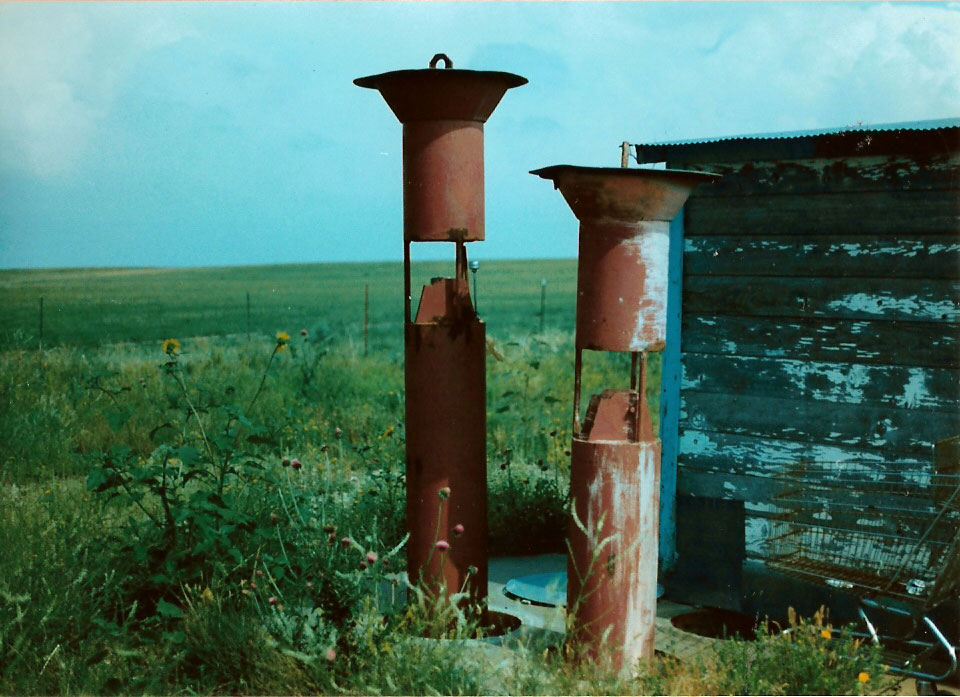
Lowry
724-B: It appears that the other two tubes are missing-- and that cart
is a long way from Safeway.
Photo
courtesy of Fred Epler
|
The
Descent of Man
The
Impetus for heading underground-- beneath the Earth's surface-- was
obvious. As always, most developments in Man's history are driven
by war. With the advent of the Nuclear Age, it suddenly became
incredibly difficult and impractical to build a surface structure that
could survive an attack. When I say difficult
and impractical,
that really translates to expensive beyond measure.
Certainly solutions existed but they were stupendously costly and
required far more money and time
than anyone was comfortable with. To
alleviate this problem, the simple solution was to use the earth itself
to help shield men and their ability to conduct war from the dreaded new
menace from which there seemed-- duck
and cover notwithstanding-- no
defense. The solution was still stupendously expensive, but just
affordable enough to come to fruition.
And
so it was that bunkers and bomb shelters of old were found woefully
inadequate in terms of survivability once the genie was out of the
bottle and we were no longer the only kids on the block with the hottest
new toy. The game had changed, as it always does, and it seemed quite lucky that good old soil and stone was
fairly difficult to displace even with the most destructive weapons ever
devised; just put enough of them between you and your hardened facility
and your chances for survival and/or counter-attack greatly increased.
To
survive, you had to go deeper underground and use far more concrete and
steel-- even then a direct hit would cripple or kill just about
anything. Going underground was just part of the game. You
also had to play the numbers and spread yourself around hoping your
enemy would miss or not be able to target you in many different places
at once.
Thus
the underground missile complex was born, and early in the history of
missile defense, the Titan 1 would emerge in the furious tennis match
between nations as yield, accuracy, distance and clever methods such as
decoys, MIRVs and other innovations would trim the narrow margin for strategic
advantage again and again. This solution seemed quite adequate for
a time, or at least it was all that could be done on short notice.
In a few short years, projects of incredible scope and cost would
consume labor and raw materials, often outstripping supply in the race
to protect ourselves from
the weapon we had so hastily developed.
It
is this stage you are borne to immediately when you enter one of these
missile sites. Your imagination cannot help but conjure scenario
after scenario as you are literally engulfed-- submerged even-- in
history itself. It is impossible not to wonder about the people
who manned these weapons: what was it like to command such power,
and in contrast, to perform the mundane everyday tasks required of a
missile crew with their terrible responsibility?
What
was it like? How did it feel to be on a missile crew
and to tend to such forces, held deceptively in check? What could
it have been like to be on alert during the Cuban Missile Crisis when
the two most destructive arsenals on Earth could have been loosed upon
one another?
Only
the missile crews could ever know for sure.
To
everyone else, it seems impossible to understand; those days are gone,
the game has changed, but as you enter this concrete sarcophagus, you'll
get as close to knowing as you ever can.
Let's
go down deep into history and enter the lair of the Titans...
|
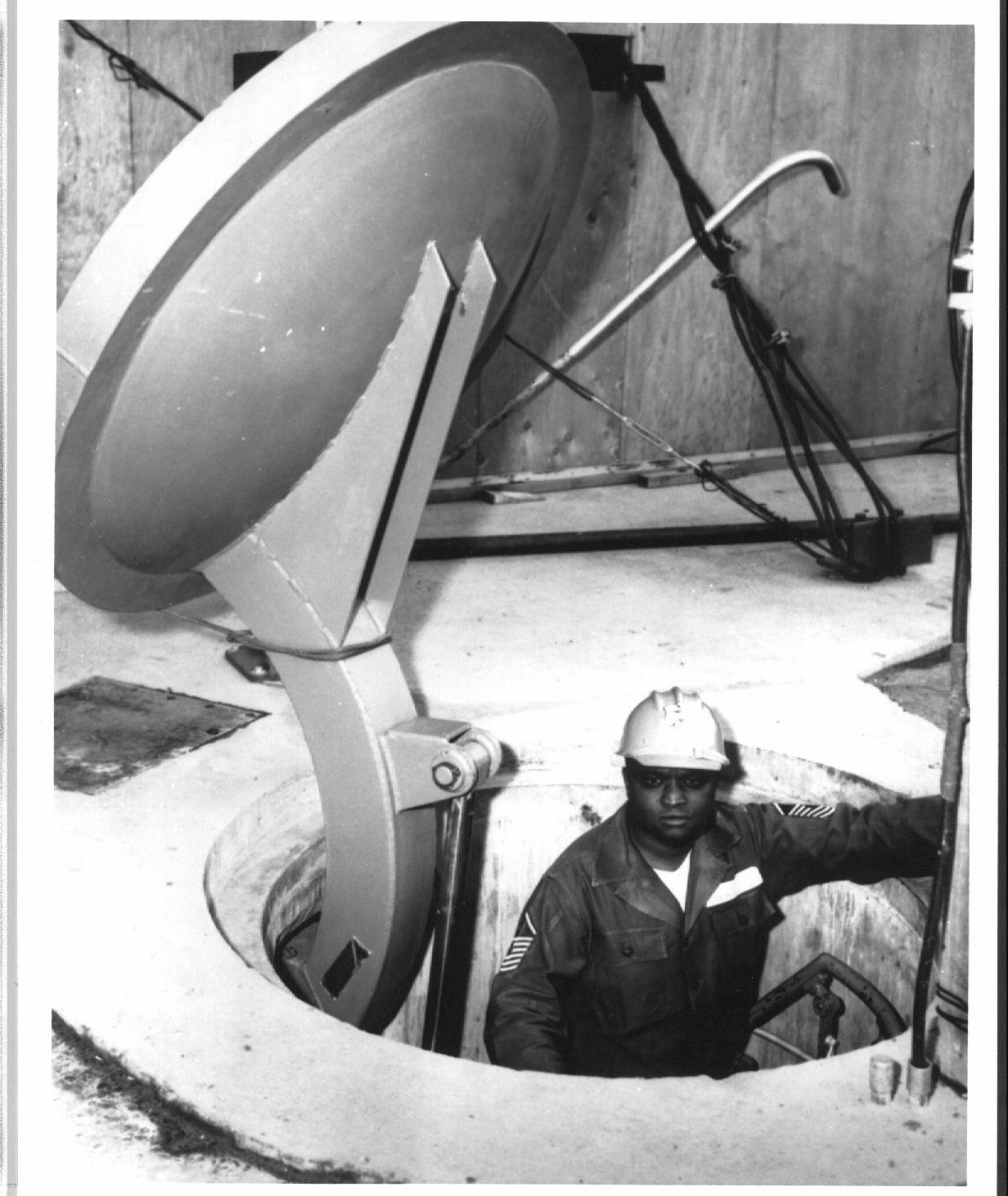
Construction
photo of the Titan I personnel entrance, circa 1960-61. Senior Master Sergeant
Abraham McMillan is shown here leaving the complex via the original
hatch. SMSgt. McMillan was a BMAT (Ballistic Missile Analyst
Technician) on launch crew R-01.
I quickly discovered that
the insignia the SMSgt. is wearing is now obsolete and it took me a
good hour to nail down what rank it represented. I went on to
state (quite incorrectly) that the insignia was changed in the 1960's--
a conclusion reached from sources on the internet. Live and learn
it turns out.
SMSgt.
McMillan's
insignia, a chevron with one stripe pointing up, and six pointing down, fell out of use somewhere in
1991 and was replaced with
the current design bearing two upward stripes and five downward
stripes. Details on how this change of insignia, which came about
through the creation of new "supergrade" ranks occurred was
graciously provided by Mike Jackson, SMSgt, USAF (Ret)
through his citation of the following linked document from the Air Force Enlisted Heritage Research Institute
by SMSgt. Michael L. Stewart, dated 22 July 1997. Read
it here.
Photo
courtesy of Fred Epler
|
|
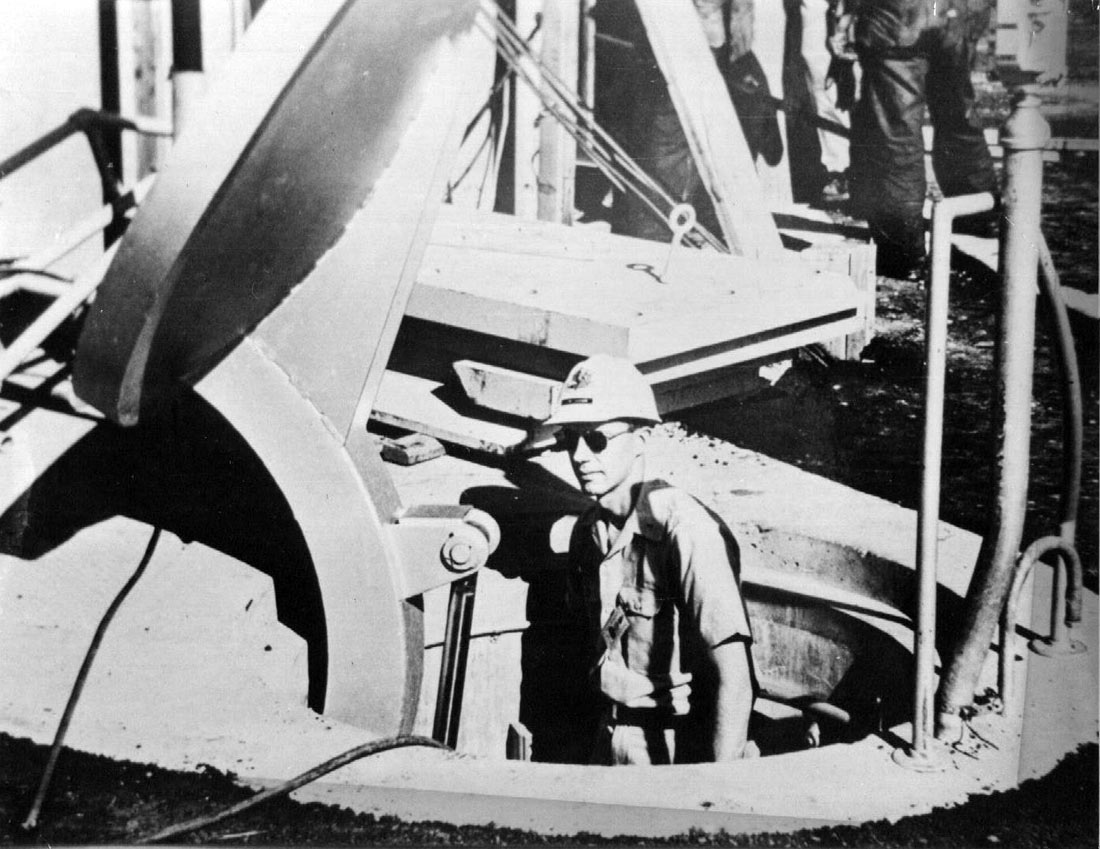
Unknown airman entering via the hatch and wearing completely different
khaki fatigues known as 1505's. Could be an officer-- after all, he's got those shades
on. Any info on the man in this photo would be greatly
appreciated. Contact
me.
There
is still some construction going on here as evidenced by the wires
running down the portal and lumber, etc. in the background.
Photo
courtesy of Fred Epler
|
|
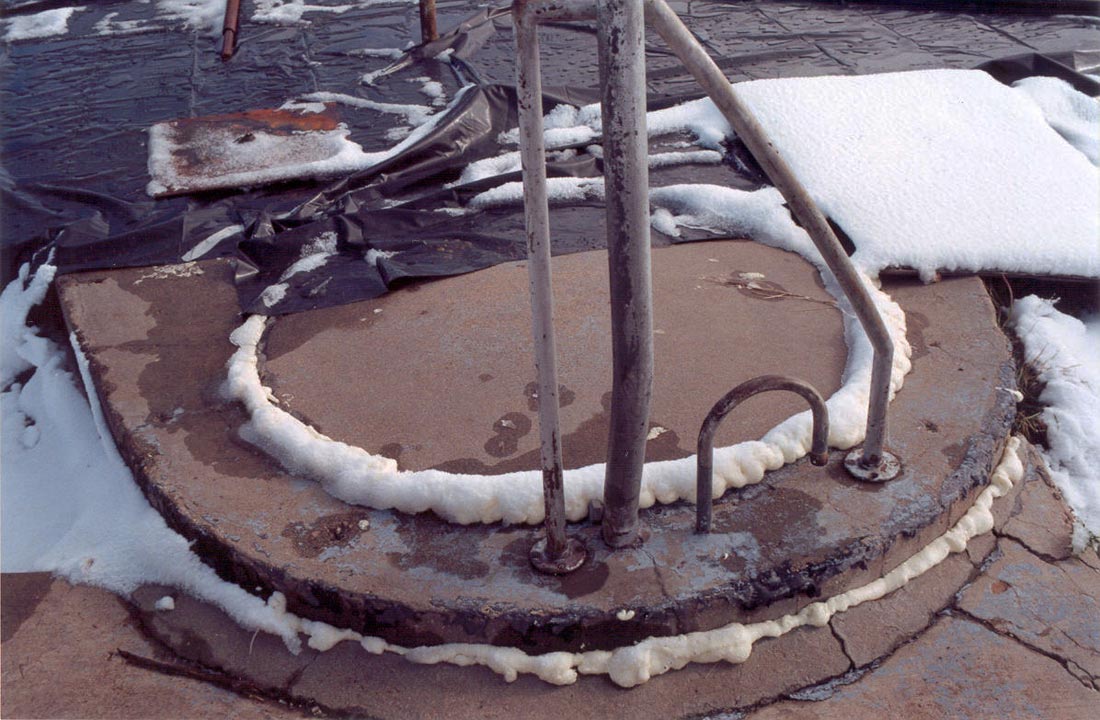
The
original hatch at Lowry 724-C, Winter 1999. In an attempt to stem
the flow of infiltrating water, the portal was covered in plastic, and
any crack, crevice or suspect cranny was filled with expanding foam
insulation. This proved futile of course as both plastic wrap, and
especially expanding foam, are very susceptible to the elements.
Wind and cold shredded the plastic and blew it away, and ultra-violet
light utterly disintegrated the foam in about a year's time. If
you look at the first image in this section you can just make out what
few tatters of plastic remain.
This
hatch has probably not been open since 1965 or earlier.
|
|
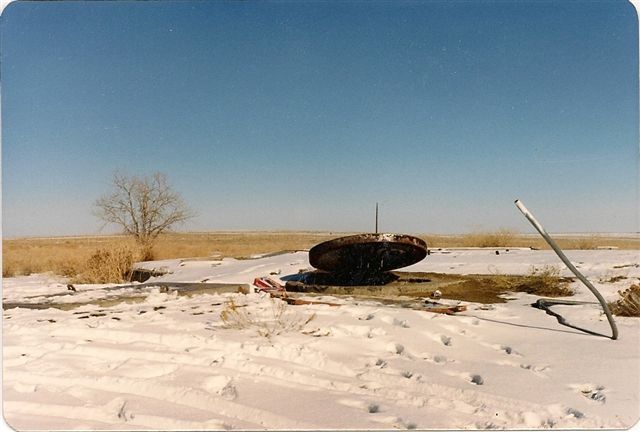
Lowry 725-A,
Winter 1986: Propped partially open, this site saw many, many
visitors over the decades after salvage. There is far more graffiti
inside it than perhaps all 5 of the other Lowry sites.
Photo
courtesy of Jim Despres
|
|

Lowry
725-A, 1986: For many many years, this entrance remained wide
open. There were a number of attempts to close up all entrances
into the site, the most recent being in 2005. The earlier efforts
were largely unsuccessful, but now this hatch is sealed and buried along
with the other routes into the complex.
Photo
courtesy of Jim Despres
|
|
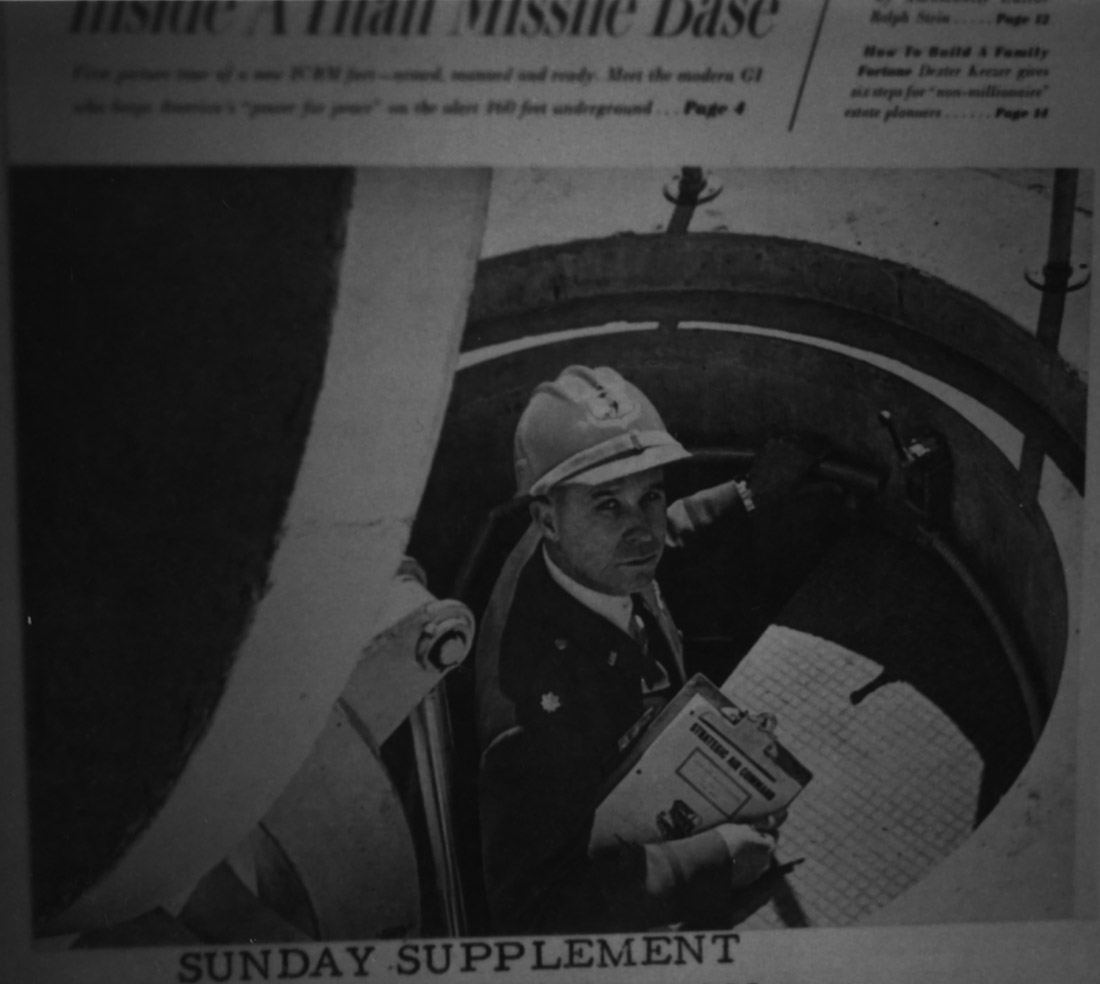
Lieutenant Colonel
Robert F. Simpson emerges from a Titan 1 complex on the cover
of This Week Magazine, a supplement of the New York Herald
Tribune featuring an exposť on the inner workings of
the missile system. Lt. Colonel Simpson was the first commander at
Lowry 724-B.
This photo is a nice view of the entry portal
showing the non-skid metal steps of the spiral stairs. Near Lt.Col.
Simpson's left hand is the limit switch that contacted with the closed
hatch to detect if it was open or closed.
Photo
courtesy of Fred Epler
|
|
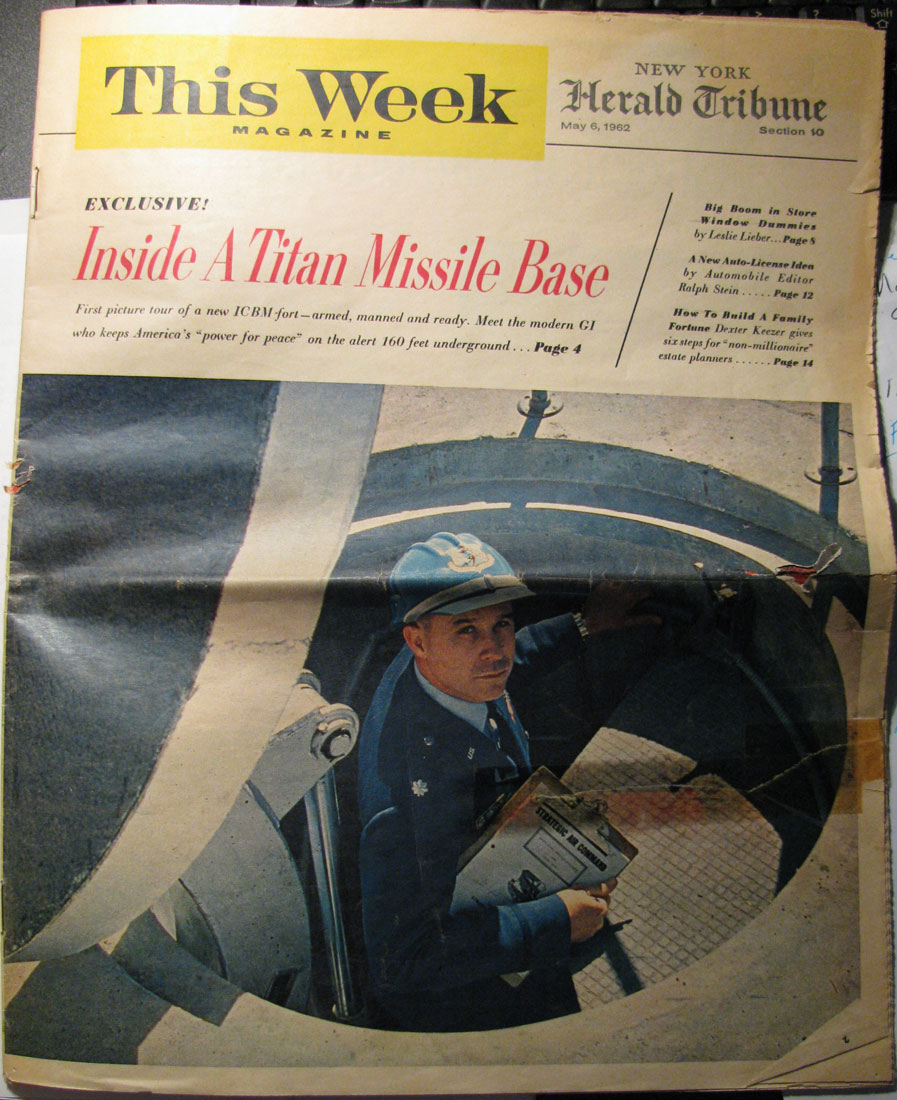
Color
photo of the This Week Magazine cover. This article came out
shortly after the Lowry sites became operational. Click
here to read the full article.
Photo
courtesy of Fred Epler
|
|
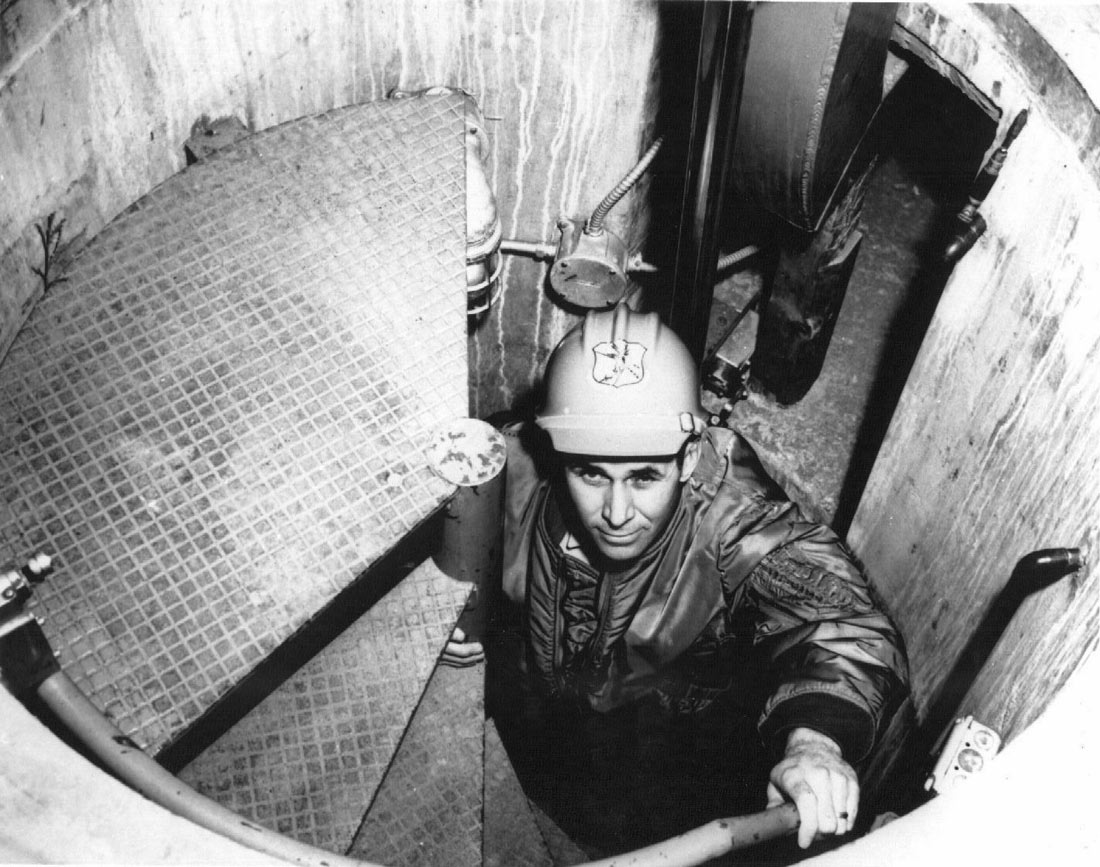
Captain
Don Smith makes his way up the steep and confined stairs of the
entry portal personnel entrance wearing his stylish flight jacket. The rather cramped and unsafe
nature of this entry would bring about its eventual abandonment early in
the sites' history. A larger entrance with a
set of regular steps and a new heavier cover would be hastily
retro-fitted to the sites, putting an end to the "gofer hole"
experience.
Captain
Smith was a GEO (Guidance Electronics Officer) with launch crew R-01.
Photo
courtesy of Fred Epler
|
Originally,
entrance to the Titan 1 complex was through the round hatch shown in the
previous photos and down a set of
spiral stairs. This was later modified to the configuration shown
below for safety reasons. Apparently, the change came following a fatal accident
in 1961 at 724-C when a civilian worker slipped at the bottom of the
steps and was fatally injured by the revolving door.
Apparently
he was preceded by another worker that had just passed through the heavy
revolving door which was still moving when he fell into it. Certainly a
gruesome end, which would be more than enough justification for a
design change.
|
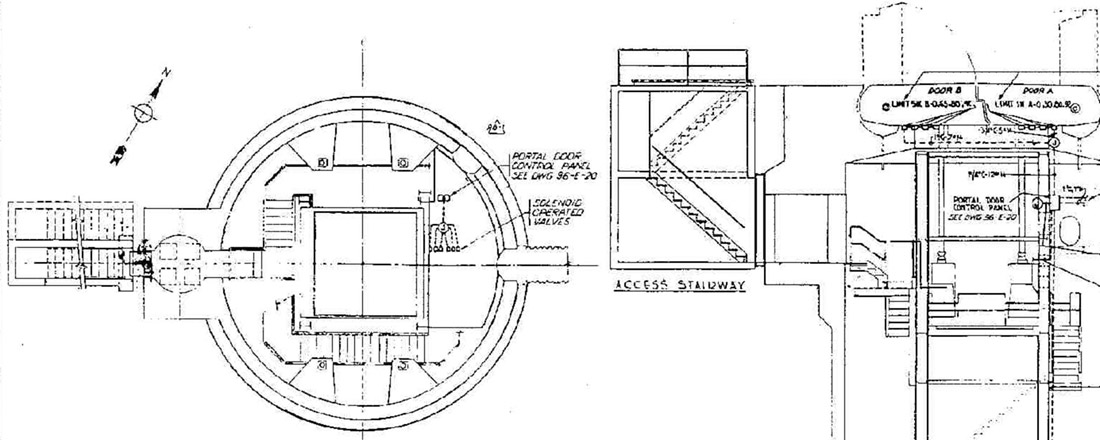
Blueprint
of the personnel entrance at one of the Mountain Home sites in Idaho
showing the re-worked, safer and much roomier design. This
replaced the decidedly more cramped and apparently dangerous design used
at the Lowry sites, which were the first to be constructed.
Photo
courtesy of Fred Epler
|
|
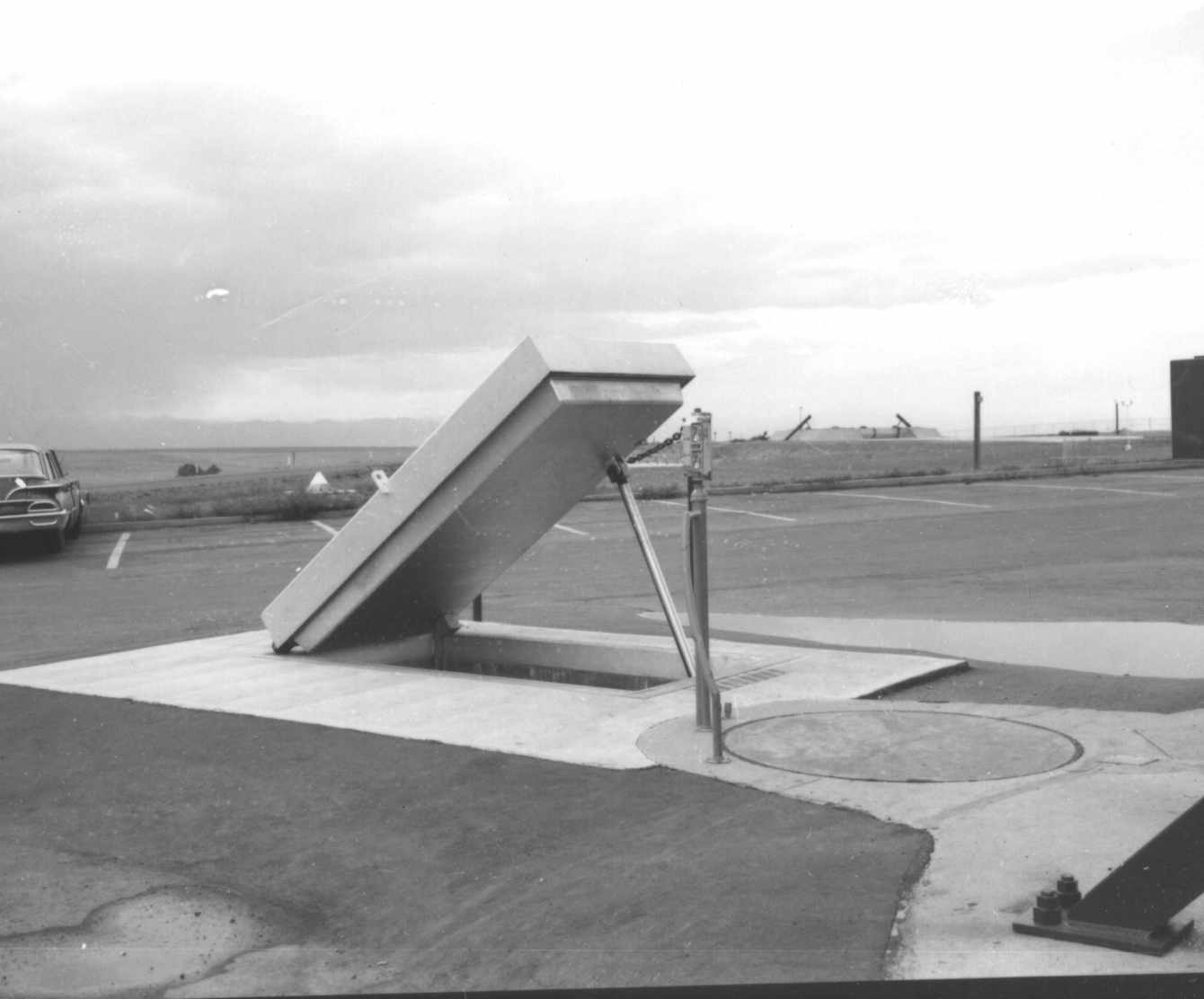
Looking
northwest: The newly-installed personnel entrance at one of the Lowry
sites. The new design used a concrete slab about a foot thick,
encased in heavy steel. The new stairs dispensed with the spiral
design and were much wider. The doors of launcher silo #1 are
visible in the background.
Photo
courtesy of Fred Epler
|
|
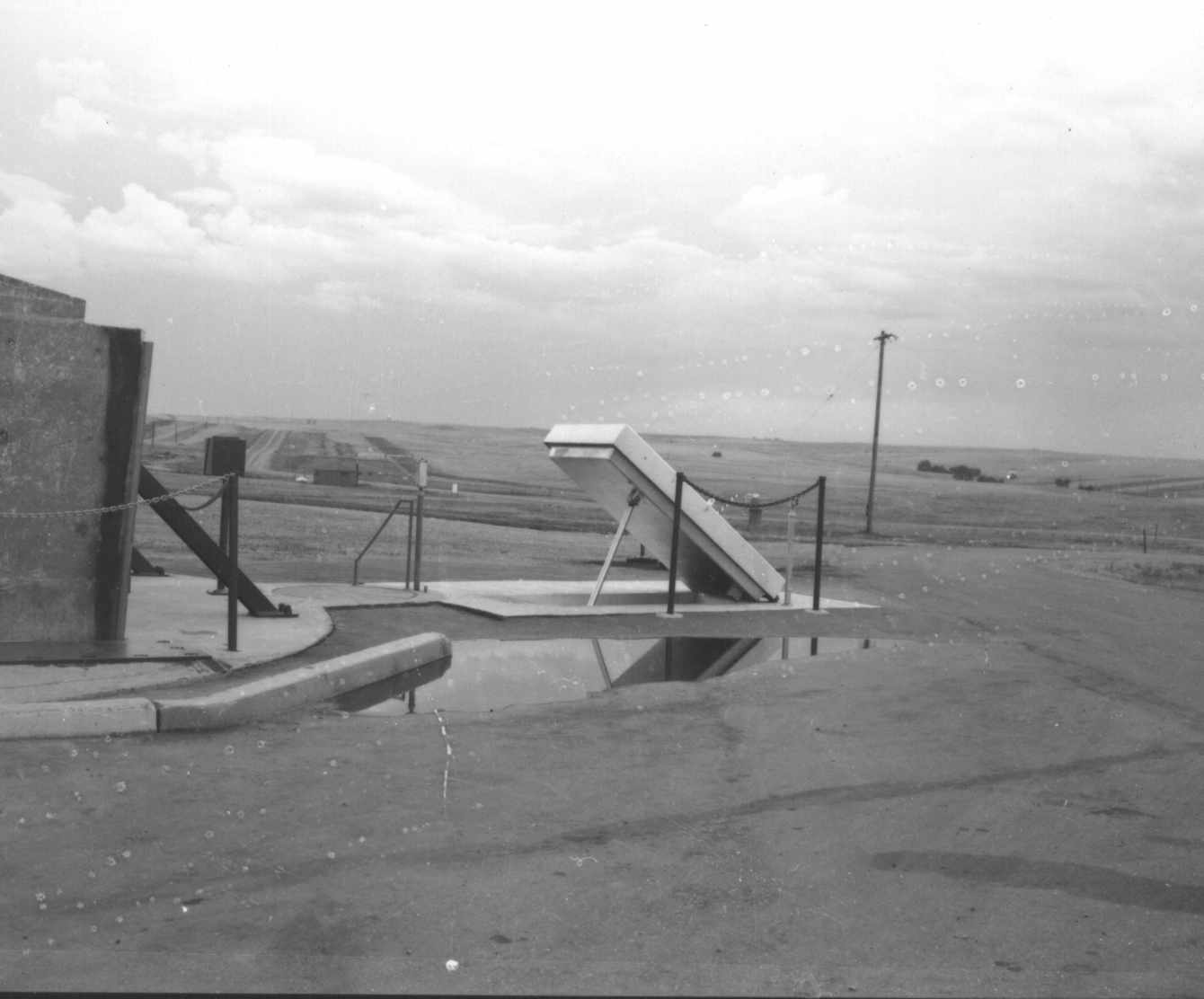
Lowry:
Looking
southwest: Pristine asphalt and a clean new look about a very new Lowry
complex.
Photo
courtesy of Fred Epler
|
|
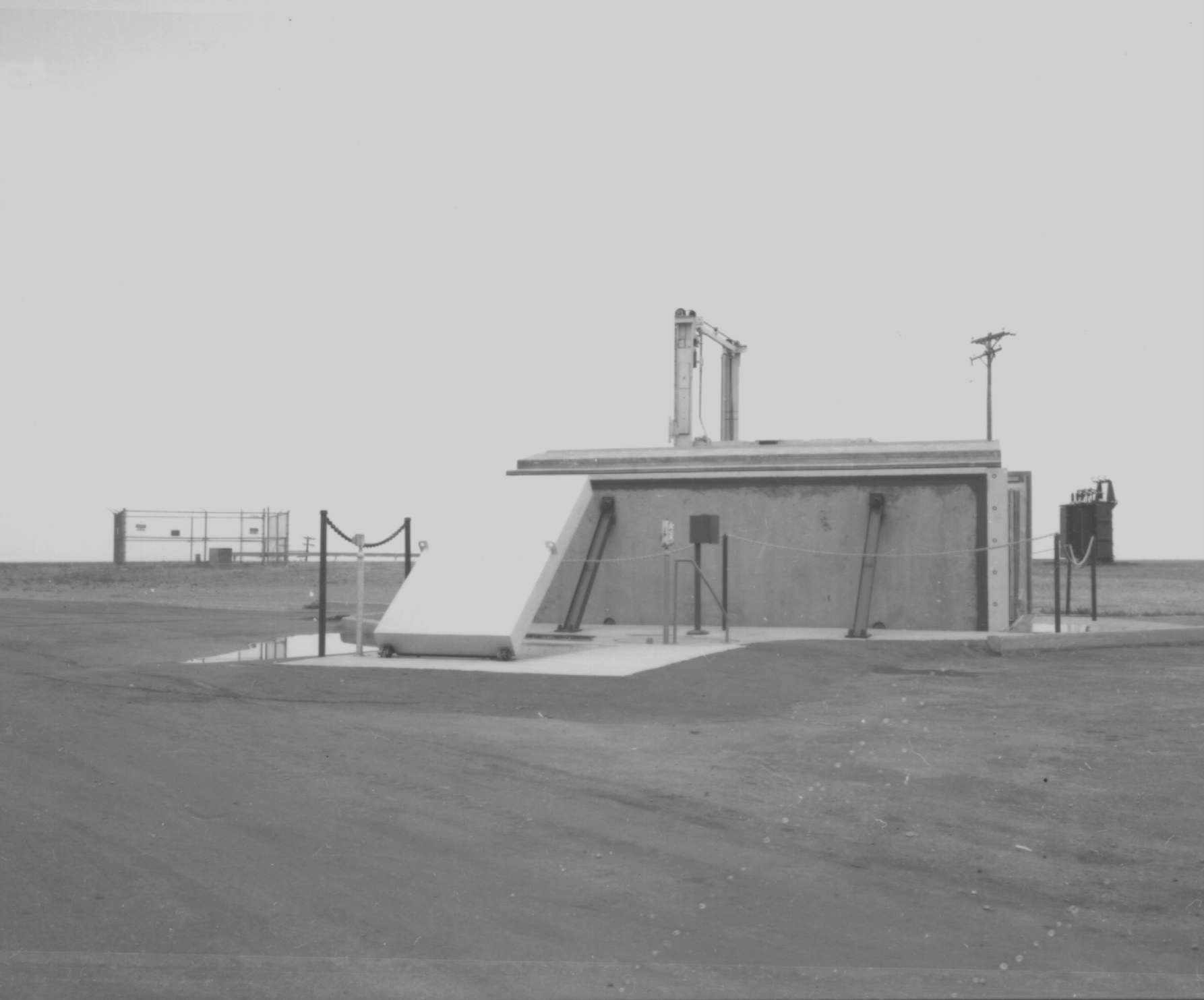
Looking
east: another look at the modified entrance and a glimpse of the freight
elevator peeking above the silo doors.
Photo
courtesy of Fred Epler
|
|
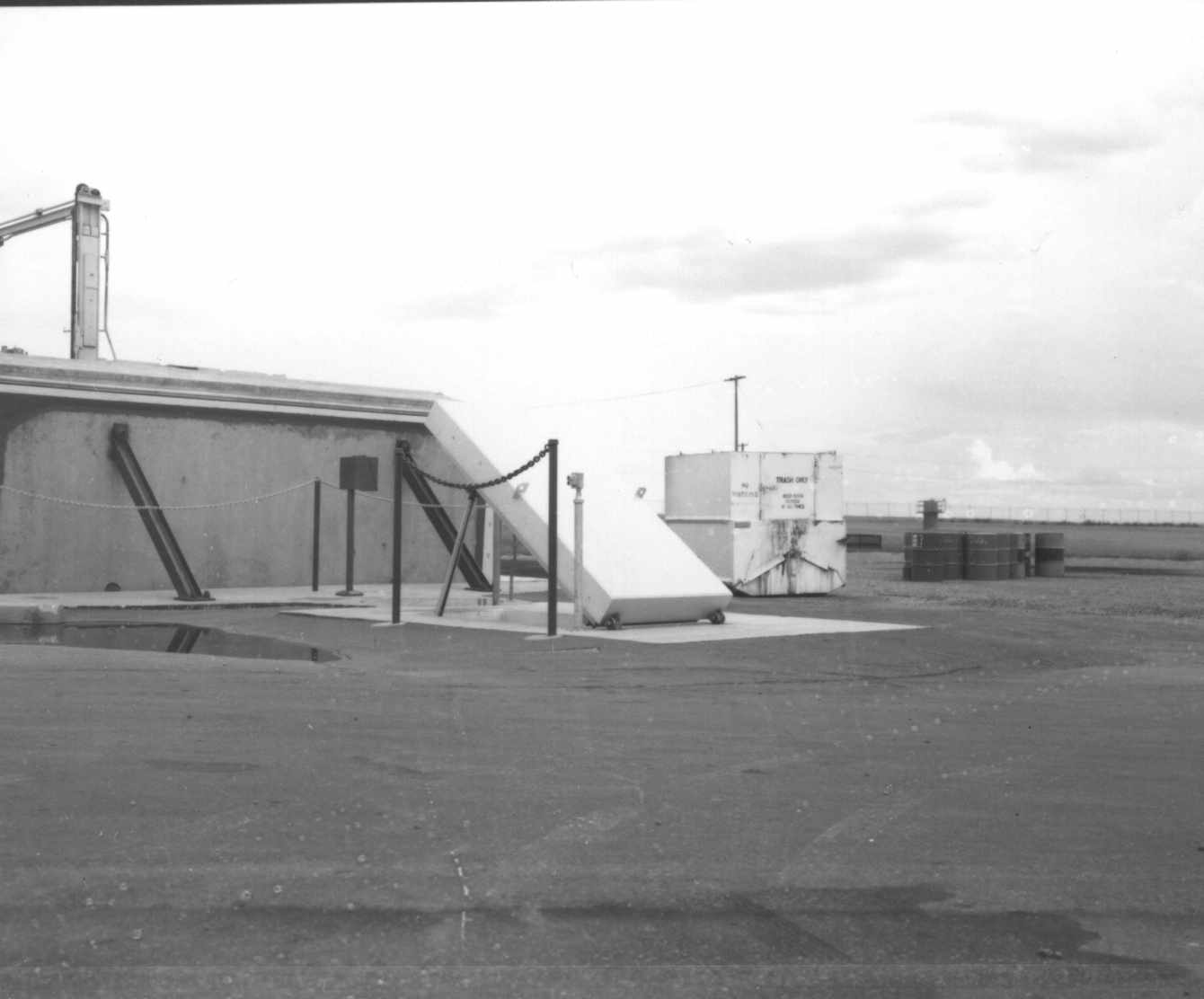
Looking
southeast: one last look at the personnel entrance and entry portal silo
doors.
Photo
courtesy of Fred Epler
|
|

Lowry
724-A: Old and new personnel entrances
Photo
courtesy of Fred Epler
|
As
these photos clearly show, at some sites, gaining entrance wasn't
exactly challenging. Attempts to secure the sites were made, but
often proved inadequate or underestimated the lengths to which the
curious will go.
Time
and time again, despite concerted efforts, teens, partiers, transients
and the aforementioned curious and missile-obsessed, thwarted just about
every obstacle placed before them and the Titan I complexes.
Around
1986, a kid broke his leg while exploring 725-A and finally,
crews were hired to try and batten down the many hatches of the Titans:
entrances were covered with concrete and steel; holes were filled in
with earth; steel was welded across openings; concrete blocks were
emplaced to hold hatches closed.
For
a while perhaps these things may have worked, but before long (and after
some careful thought perhaps) people came back and found new ways in or
worked on the new barriers with pry bars, sledge hammers and hack saws
until they failed.
|
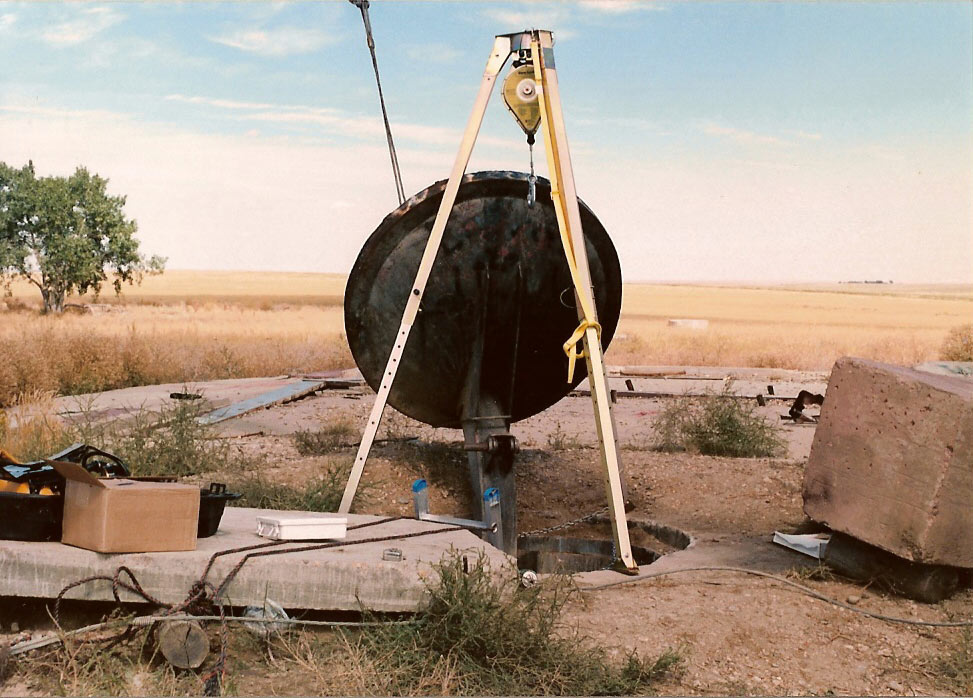
Lowry
725-A, circa 1994: Site was opened up during an environmental
survey. You can see a large concrete block on the right that had
been down the hatch, and a concrete pad on the left that had been used
to cover the hatch opening. This very hatch was where my first
glimpse of a Titan 1 began.
Photo
courtesy of Fred Epler
|
|
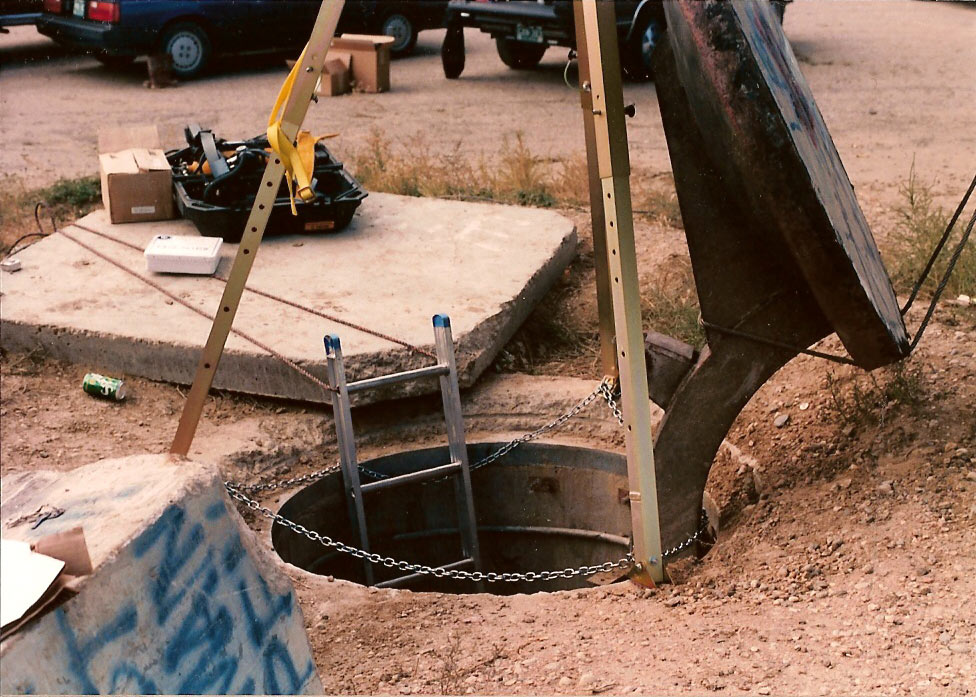
Lowry
725-A, circa 1994: A closer look at the old personnel entrance.
The newer cellar stairs entrance is nearby, partially buried and covered
with the original steel and concrete lid.
Photo
courtesy of Fred Epler
|
|
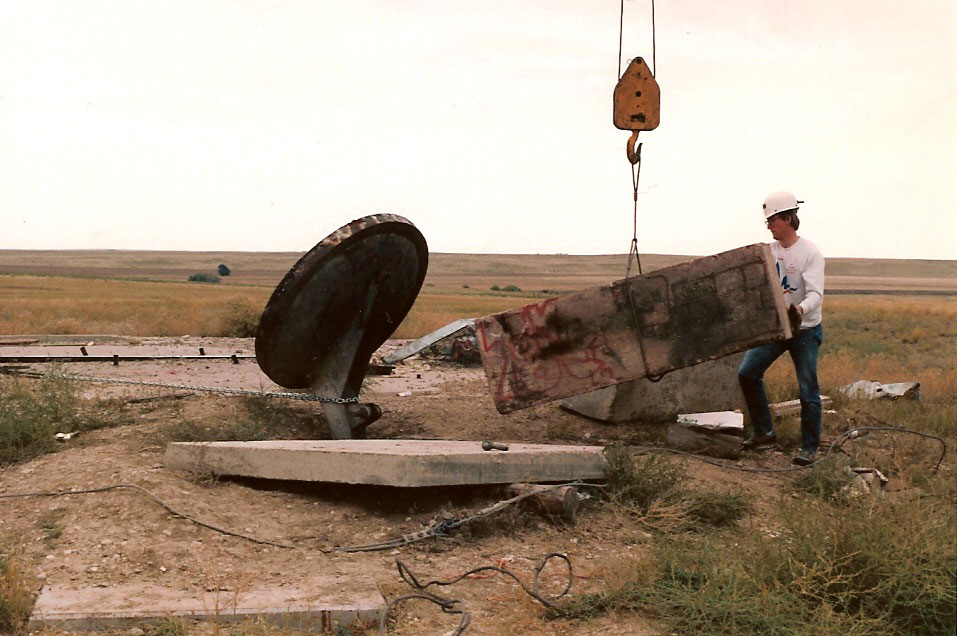
Lowry
725-A, circa 1994: Replacing concrete blocks following an environmental
survey. When I arrived, the blocks were still in place but the
concrete pad had been moved. You can see the cellar stairs lid
partially visible on the lower left protruding from under the dirt.
Photo
courtesy of Fred Epler
|
|

Lowry
725-A, circa 1998: A bigger, tougher concrete pad blocks entry.
How long would this one last? You can see the edges are chipped
and broken, giving the appearance that determined forces have been hard
at work trying to dislodge this barrier. No matter, other ways
were found to gain entry, requiring further work to seal up the site in
2005.
Photo
courtesy of Fred Epler
|
|
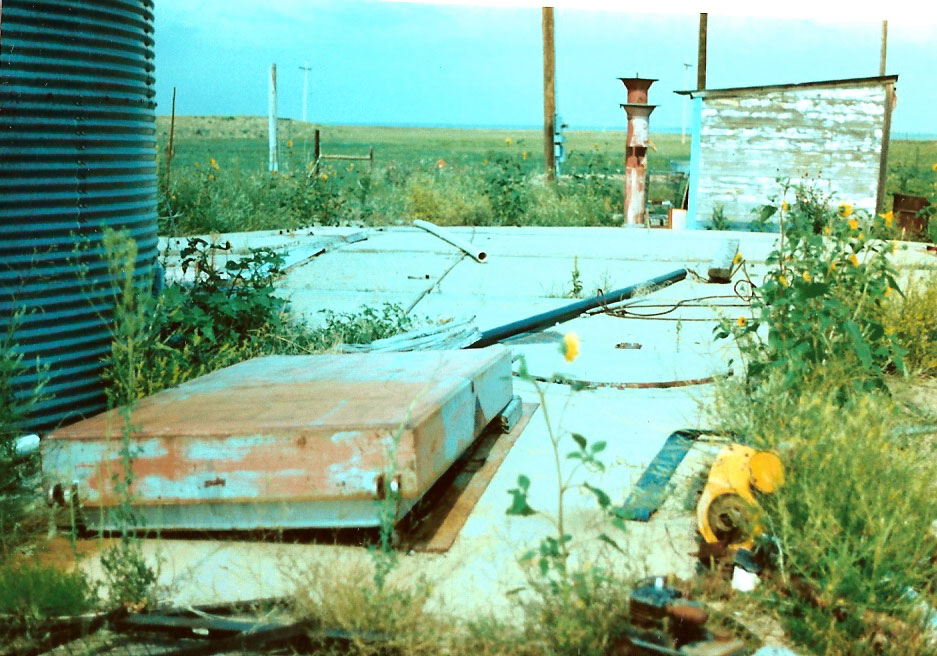
Lowry
724-B: Steel and concrete hatch cover rests askew over the
entrance. That's a grain bin on the left-- this site has been used
for cattle grazing for many years. Part of the instrument array
can be seen next to the wooden shed in the background.
Photo
courtesy of Fred Epler
|
|

Lowry
724-B: This entrance has probably been more effectively closed since this
photo was taken. You can see that this dog could squeeze in
there, but a grown man of average size would probably find it very
difficult if not impossible to fit through there. However, a woman
of slight build from the Colorado Dept. of Health and Environment (CDPHE)
apparently could indeed fit through there. She encountered water
just a few feet down below.
Photo
courtesy of Fred Epler
|
|
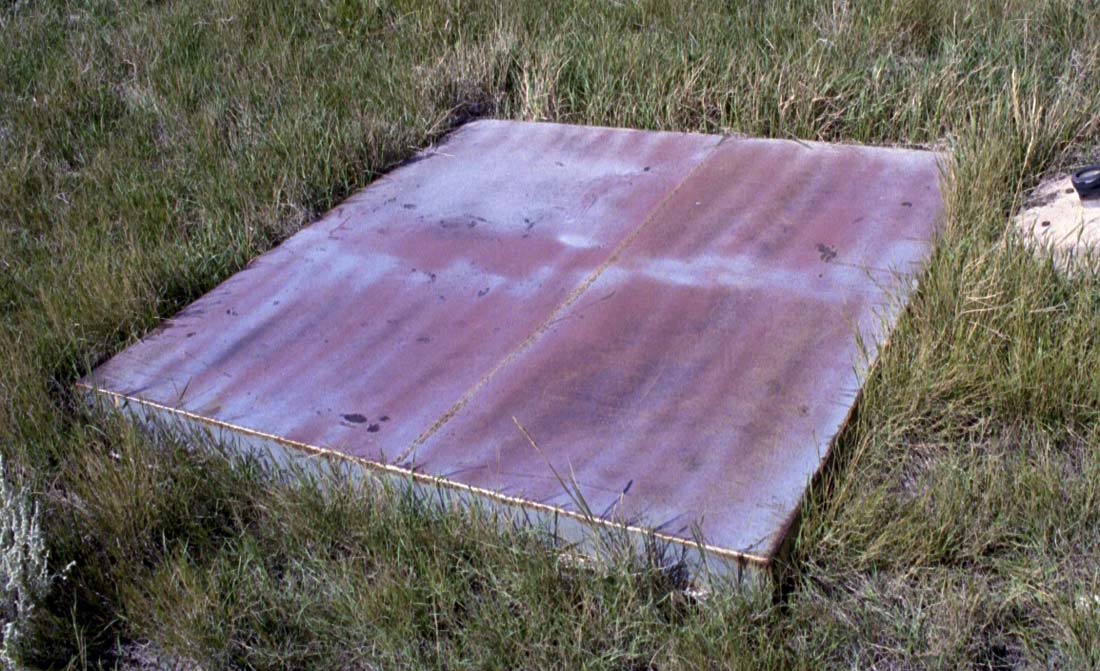
Lowry
724-C, 1999: The heavy hatch cover lays some 50 feet away from the
entrance. A newer steel cover has been made to replace this much
heavier one.
|
I
never even saw the launcher silo doors during my visit to
725-A. I saw tall grass and weeds surrounding a rather
unremarkable hole in the ground. There was a cover for the hole
which was propped open with a wooden fence post. Looking down the
hole I could see dirt and large concrete blocks-- obviously placed there
for the express purpose of keeping curious folk like myself and my
companion from getting inside. These efforts were dreadfully
unsuccessful as the concrete blocks, which were too small to fill the
opening and left a gaping hole, did nothing to prevent our invasion, and
in fact, made descent much easier.
Handholds
and footholds galore were provided by the concrete blocks giving
precious purchase to aid in our exploration. We arrived at the bottom
without incident and confident of our ability to climb back out again
later.
We
stood on the vestibule of the great portal, our eyes adjusting, our ears
straining in the silence. A strange odor never before experienced
filled my nose; we were inside, but what was down there?. I had no idea what I was in for
and no clue how it would profoundly change my life.
We
turned on our flashlights and began to descend...
---------------------------
Next:
head into the underground complex and re-trace my steps as you
explore the dark depths of a nuclear missile's warren.
Click the link below or you can go to the Main
Map to explore elsewhere.
Entry
Portal section IV or Go
to Main Map

| Contact |
Site Map | Links
|
Hosted by
InfoBunker





